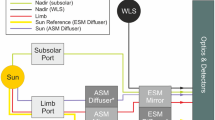Abstract
The imaging interferometer (IIM) aboard the Chang’E-1 lunar orbiter is the first multispectral imaging spectrometer for Chinese lunar missions. Before science applications (e.g., FeO and TiO2 mapping) of the IIM raw data, the radiance variation due to changes in illumination and viewing geometry has to be removed from the radiometrically calibrated IIM Level 2A images. To achieve this, we fit the IIM Level 2A radiance data with a Lommel-Seeliger photometric model consisting of an exponential term and a fourth order polynomial in the phase function, without distinguishing between lunar maria and highlands. The exponential and the fourth order polynomial parameters are derived separately by fitting to two datasets divided at a solar phase angle threshold, avoiding a decrease in the phase function close to zero phase angle. Different phase angle thresholds result in coincident fitting curves between 20° and 75°, while large discrepancies occur at other phase angles. Then the derived photometric model is used to normalize the IIM Level 2A data to radiance values at an incidence and phase angle of 30° and emission angle of 0°. Our photometric model is validated by comparing two photometrically normalized IIM radiance spectra covering the same areas, showing a relative deviation consistent with the IIM preflight calibration.
Similar content being viewed by others
References
Ouyang Z Y, Li C L, Zou Y L, et al. The primary science result from Chang’E-1 probe (in Chinese). Sci China Earth Sci (Chin Ver), 2010, 40: 261–280
Huang Y, Hu X G, Zhang X Z, et al. Improvement of orbit determination for geostationary satellites with VLBI tracking. Chin Sci Bull, 2011, 56: 2765–2772
Ling Z C, Zhang J, Liu J Z, et al. Preliminary results of TiO2 mapping using imaging interferometer data from Chang’E-1. Chin Sci Bull, 2011, 56: 2082–2087
Jin Y Q, Fa W Z. The modeling analysis of microwave emission from stratified media of non-uniform lunar cratered terrain surface for Chinese Chang-E 1 observation. Chin Sci Bull, 2011, 56: 1165–1171
Fa W Z, Jin Y Q. Global inventory of Helium-3 in lunar regoliths estimated by a multi-channel microwave radiometer on the Chang-E 1 lunar satellite. Chin Sci Bull, 2010, 55: 4005–4009
Li J L, Guo L, Qian Z H, et al. Determination of the controlled landing trajectory of Chang’E-1 satellite and the coordinate analysis of the landing point on the Moon. Chin Sci Bull, 2010, 55: 1240–1245
Ping J S, Huang Q, Su X L, et al. Chang’E-1 orbiter discovers a lunar nearside volcano: YUTU mountain. Chin Sci Bull, 2009, 54: 4534–4536
Ling Z C, Zhang J, Liu J Z, et al. Preliminary results of FeO mapping using imaging interferometer data from Chang’E-1. Chin Sci Bull, 2011, 56: 376–379
Chen C, Qin Q M, Zhang N, et al. Research on photometric calibration and reflectance calculation of CE-1 IIS data (in Chinese). Spectrosc Spect Anal, 2011, 31: 1985–1990
Wu Y Z, Besse S, Li J Y, et al. Photometric correction and in-flight calibration of Chang’E-1 interference imaging spectrometer (IIM) data. Icarus, 2011, 222: 283–295
Hillier J K, Buratti B J, Hill K. Multispectral photometry of the Moon and absolute calibration of the Clementine UV/Vis camera. Icarus, 1999, 141: 205–225
McEwen A S. A precise lunar photometric function. Proc Lunar Planet Sci Conf, 1996, 27: 841–842
Hapke B W. Theory of reflectance and emittance spectroscopy. New York: Cambridge University Press, 1993
Denevi B W, Robinson M S, Hapke B W, et al. Global ultraviolet through visible color observations of the Moon with the lunar reconnaissance orbiter wide angle camera. Lunar and Planetary Science Conference Abstracts, 2010, 41: 2263
Hicks M D, Buratti B J, Staid M, et al. A visible and infrared spectrophotometric model for the Moon based on ROLO and Chandrayaan-1 Moon Mineralogy Mapper data. Lunar and Planetary Science Conference Abstracts, 2010, 41: 2076
Qiu Y H, Zhao B C, Zhao J K, et al. Field performance test experiments of the interference imaging spectrometer of Chang’E-1 satellite (in Chinese). Acta Photonica Sin, 2009, 38: 484–488
Author information
Authors and Affiliations
Corresponding author
Additional information
This article is published with open access at Springerlink.com
About this article
Cite this article
Zhang, J., Ling, Z., Zhang, W. et al. Photometric modeling of the Moon using Lommel-Seeliger function and Chang’E-1 IIM data. Chin. Sci. Bull. 58, 4588–4592 (2013). https://doi.org/10.1007/s11434-013-6097-3
Received:
Accepted:
Published:
Issue Date:
DOI: https://doi.org/10.1007/s11434-013-6097-3




